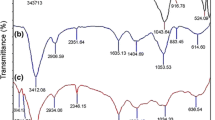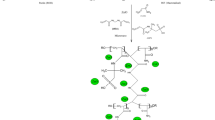Abstract
In this study, the collagen-g-poly(acrylic acid-co-N-vinylpyrrolidone)/Fe3O4@SiO2 (collagen-g-p(AA-co-NVP)/Fe3O4@SiO2) as magnetic nanocomposite hydrogel was synthesized by graft copolymerization of acrylic acid (AA) and N-vinylpyrrolidone (NVP) onto collagen in the presence of the Fe3O4@SiO2 using ammonium persulfate as a free radical initiator and bis[2-(methacryloyloxy)ethyl] phosphate as a crosslinker under ultrasound-assisted condition. The blank collagen-g-p(AA-co-NVP) hydrogel and its composite with the Fe3O4@SiO2 nanoparticles were characterized by means of FTIR, SEM-EDS, XRD, VSM and TGA methods. The effects of different parameters such as pH, dose of adsorbent and time on swelling behavior were examined. The swelling ratio of the collagen-g-p(AA-co-NVP) hydrogel increased in the presence of the Fe3O4@SiO2 nanoparticles. Adsorption behavior of magnetic nanocomposite hydrogel was investigated for the adsorption of dyes and it was found to remove about 93% for methylene blue, 96% for brilliant green and 89% for rhodamine B in 50 mg/L of dyes solutions at pH 7. Kinetic study revealed the applicability of pseudo-first-order and pseudo-second-order models for the adsorption of mentioned dyes. The adsorption isotherm was studied in 25, 35, 45 and 55 °C using Langmuir, Freundlich, Temkin and Sips models and the adsorption data were well described by Langmuir isotherm model. Negative values of ΔGº for all three dyes suggested the feasibility of dyes removal and support for spontaneous adsorption of mentioned dyes on magnetic nanocomposite hydrogel. Desorption of dyes from the dye loaded nanocomposite hydrogel was simply done in ethanol. The results indicate that the prepared magnetic nanocomposite hydrogel is an efficient adsorbent with high adsorption capacity for the aforementioned dyes.













Similar content being viewed by others
References
Wang J, Liu F (2012) UV-radiation curing of simultaneous interpenetrating polymer network hydrogels for enhanced heavy metal ion removal. Mater Sci Eng B 177:1633–1640. https://doi.org/10.1016/j.mseb.2012.08.019
Saini J, Garg VK, Gupta RK, Kataria N (2017) Removal of Orange G and Rhodamine B dyes from aqueous system using hydrothermally synthesized zinc oxide loaded activated carbon (ZnO-AC). J Environ Chem Eng 5:884–892. https://doi.org/10.1016/j.jece.2017.01.012
Shi Y, Xue Z, Wang X et al (2013) Removal of methylene blue from aqueous solution by sorption on lignocellulose-g-poly(acrylic acid)/montmorillonite three-dimensional cross-linked polymeric network hydrogels. Polym Bull 70:1163–1179. https://doi.org/10.1007/s00289-012-0898-4
Ozal E, Kuralay E, Yildirim V et al (2005) Preoperative methylene blue administration in patients at high risk for vasoplegic syndrome during cardiac surgery. Ann Thorac Surg 79:1615–1619. https://doi.org/10.1016/j.athoracsur.2004.10.038
Moawed EA, Wahba AE, Gabr RA (2018) Synthesis and application of LGB/St/Al2O3 biocomposite for sensitive detection and efficient removal of brilliant green dye from wastewater. J Environ Chem Eng 6:7225–7232. https://doi.org/10.1016/j.jece.2018.11.017
Ptaszkowska-koniarz M, Goscianska J, Pietrzak R (2018) Removal of rhodamine B from water by modified carbon xerogels. Coll Surf A 543:109–117. https://doi.org/10.1016/j.colsurfa.2018.01.057
Zhou HY, Chen XG, Kong M et al (2008) Effect of molecular weight and degree of chitosan deacetylation on the preparation and characteristics of chitosan thermosensitive hydrogel as a delivery system. Carbohydr Polym 73:265–273. https://doi.org/10.1016/j.carbpol.2007.11.026
Xu X-D, Zhang X-Z, Cheng S-X et al (2007) A strategy to introduce the pH sensitivity to temperature sensitive PNIPAAm hydrogels without weakening the thermosensitivity. Carbohydr Polym 68:416–423. https://doi.org/10.1016/j.carbpol.2006.11.019
Zhu C, Lu Y, Peng J et al (2012) Photothermally sensitive poly(N-isopropylacrylamide)/graphene oxide nanocomposite hydrogels as remote light-controlled liquid microvalves. Adv Funct Mater 22:4017–4022. https://doi.org/10.1002/adfm.201201020
Tóth IY, Veress G, Szekeres M et al (2015) Magnetic hyaluronate hydrogels: preparation and characterization. J Magn Magn Mater 380:175–180. https://doi.org/10.1016/j.jmmm.2014.10.139
Bexiga NM, Bloise AC, de Moraes MA et al (2017) Production and characterization of fibroin hydrogel using waste silk fibers. Fibers Polym 18:57–63. https://doi.org/10.1007/s12221-017-6805-8
Mohammadinezhad A, Bagheri Marandi G, Farsadrooh M, Javadian H (2018) Synthesis of poly(acrylamide-co-itaconic acid)/MWCNTs superabsorbent hydrogel nanocomposite by ultrasound-assisted technique: Swelling behavior and Pb (II) adsorption capacity. Ultrason Sonochem 49:1–12. https://doi.org/10.1016/j.ultsonch.2017.12.028
Mallakpour S, Jarahiyan A (2017) Utilization of ultrasonic irradiation as a green and effective strategy to prepare poly(N-vinyl-2-pyrrolidone)/modified nano-copper (II) oxide nanocomposites. Ultrason Sonochem 37:128–135. https://doi.org/10.1016/j.ultsonch.2017.01.002
Shirsath SR, Patil AP, Patil R et al (2013) Removal of Brilliant Green from wastewater using conventional and ultrasonically prepared poly(acrylic acid) hydrogel loaded with kaolin clay: a comparative study. Ultrason Sonochem 20:914–923. https://doi.org/10.1016/j.ultsonch.2012.11.010
Wang X, Wang Y, He S et al (2018) Ultrasonic-assisted synthesis of superabsorbent hydrogels based on sodium lignosulfonate and their adsorption properties for Ni2+. Ultrason Sonochem 40:221–229. https://doi.org/10.1016/j.ultsonch.2017.07.011
Chen J, Feng J, Yan W (2016) Influence of metal oxides on the adsorption characteristics of PPy/metal oxides for methylene blue. J Colloid Interface Sci 475:26–35. https://doi.org/10.1016/j.jcis.2016.04.017
Saini J, Garg VK, Gupta RK (2018) Removal of methylene blue from aqueous solution by Fe3O4@Ag/SiO2 nanospheres: synthesis, characterization and adsorption performance. J Mol Liq 250:413–422. https://doi.org/10.1016/j.molliq.2017.11.180
Hu X, Wang Y, Zhang L et al (2018) Design of a pH-sensitive magnetic composite hydrogel based on salecan graft copolymer and Fe3O4@SiO2 nanoparticles as drug carrier. Int J Biol Macromol 107:1811–1820. https://doi.org/10.1016/j.ijbiomac.2017.10.043
Li J, Feng J, Yan W (2013) Excellent adsorption and desorption characteristics of polypyrrole/TiO2 composite for methylene Blue. Appl Surf Sci 279:400–408. https://doi.org/10.1016/j.apsusc.2013.04.127
Ayawei N, Ebelegi AN, Wankasi D (2017) Modelling and interpretation of adsorption isotherms. J Chem 2017:1–11. https://doi.org/10.1155/2017/3039817
Foo KY, Hameed BH (2010) Insights into the modeling of adsorption isotherm systems. Chem Eng J 156:2–10. https://doi.org/10.1016/j.cej.2009.09.013
Mahdavi M, Ahmad M, Haron M et al (2013) Synthesis, surface modification and characterisation of biocompatible magnetic iron oxide nanoparticles for biomedical applications. Molecules 18:7533–7548. https://doi.org/10.3390/molecules18077533
Bagheri Marandi G, Mahdavinia GR, Ghafary S (2011) Collagen-g-poly(Sodium Acrylate-co-Acrylamide)/sodium montmorillonite superabsorbent nanocomposites: synthesis and swelling behavior. J Polym Res 18:1487–1499. https://doi.org/10.1007/s10965-010-9554-6
Mittal H, Kumar V, Saruchi SS (2016) Adsorption of methyl violet from aqueous solution using gum xanthan/Fe3O4 based nanocomposite hydrogel. Int J Biol Macromol 89:1–11. https://doi.org/10.1016/j.ijbiomac.2016.04.050
Bagheri Marandi G, Kermani ZP, Kurdtabar M (2013) Fast and efficient removal of cationic dyes from aqueous solution by collagen-based hydrogel nanocomposites. Polym Plast Technol Eng 52:310–318. https://doi.org/10.1080/03602559.2012.748806
Kurdtabar M, Peyvand Kermani Z, Bagheri Marandi G (2015) Synthesis and characterization of collagen-based hydrogel nanocomposites for adsorption of Cd2+, Pb2+, methylene green and crystal violet. Iran Polym J 24:791–803. https://doi.org/10.1007/s13726-015-0368-6
Dil NN, Sadeghi M (2018) Free radical synthesis of nanosilver/gelatin-poly (acrylic acid) nanocomposite hydrogels employed for antibacterial activity and removal of Cu(II) metal ions. J Hazard Mater 351:38–53. https://doi.org/10.1016/j.jhazmat.2018.02.017
Mittal H, Ray SS (2016) A study on the adsorption of methylene blue onto gum ghatti/TiO2 nanoparticles-based hydrogel nanocomposite. Int J Biol Macromol 88:66–80. https://doi.org/10.1016/j.ijbiomac.2016.03.032
Zhang L, Shao H, Zheng H et al (2016) Synthesis and characterization of Fe3O4@SiO2 magnetic composite nanoparticles by a one-pot process. Int J Miner Metall Mater 23:1112–1118. https://doi.org/10.1007/s12613-016-1329-6
Liu X, Tao Y, Mao H et al (2017) Construction of magnetic-targeted and NIR irradiation-controlled drug delivery platform with Fe3O4@Au@SiO2 nanospheres. Ceram Int 43:5061–5067. https://doi.org/10.1016/j.ceramint.2017.01.017
Ismail M, Kamal A, Hanafiah M et al (2015) Kinetics of methylene blue adsorption on sulphuric acid treated coconut (Cocos nucifiera) frond powder. Am J Environ Eng 5:33–37. https://doi.org/10.5923/c.ajee.201501.06
Harifi T, Montazer M (2014) In situ synthesis of iron oxide nanoparticles on polyester fabric utilizing color, magnetic, antibacterial and sono-fenton catalytic properties. J Mater Chem B 2:272–282. https://doi.org/10.1039/C3TB21445A
Khalid I, Ahmad M, Minhas MU, Barkat K (2018) Synthesis and evaluation of chondroitin sulfate based hydrogels of loxoprofen with adjustable properties as controlled release carriers. Carbohydr Polym 181:1169–1179. https://doi.org/10.1016/j.carbpol.2017.10.092
Hur J, Im K, Kim SW et al (2014) Polypyrrole/agarose-based electronically conductive and reversibly restorable hydrogel. ACS Nano 8:10066–10076. https://doi.org/10.1021/nn502704g
Nath J, Dolui SK (2018) Synthesis of carboxymethyl cellulose-g-poly (acrylic acid)/ LDH hydrogel for in vitro controlled release of vitamin B12. Appl Clay Sci 155:65–73. https://doi.org/10.1016/j.clay.2018.01.004
Dargahi M, Ghasemzadeh H, Bakhtiary A (2018) Highly efficient absorption of cationic dyes by nano composite hydrogels based on κ-carrageenan and nano silver chloride. Carbohydr Polym 181:587–595. https://doi.org/10.1016/j.carbpol.2017.11.108
Taghvay Nakhjiri M, Bagheri Marandi G, Kurdtabar M (2018) Poly(AA-co-VPA) hydrogel cross-linked with N-maleyl chitosan as dye adsorbent: Isotherms, kinetics and thermodynamic investigation. Int J Biol Macromol 117:152–166. https://doi.org/10.1016/j.ijbiomac.2018.05.140
Mittal H, Parashar V, Mishra SB, Mishra AK (2014) Fe3O4 MNPs and gum xanthan based hydrogels nanocomposites for the efficient capture of malachite green from aqueous solution. Chem Eng J 255:471–482. https://doi.org/10.1016/j.cej.2014.04.098
Foorginezhad S, Zerafat MM (2017) Microfiltration of cationic dyes using nano-clay membranes. Ceram Int 43:15146–15159. https://doi.org/10.1016/j.ceramint.2017.08.045
Aflaki Jalali M, Dadvand Koohi A, Sheykhan M (2016) Experimental study of the removal of copper ions using hydrogels of xanthan, 2-acrylamido-2-methyl-1-propane sulfonic acid, montmorillonite: Kinetic and equilibrium study. Carbohydr Polym 142:124–132. https://doi.org/10.1016/j.carbpol.2016.01.033
Bagheri Marandi G, Baharloui M, Kurdtabar M et al (2015) Hydrogel with high laponite content as nanoclay: swelling and cationic dye adsorption properties. Res Chem Intermed 41:7043–7058. https://doi.org/10.1007/s11164-014-1797-0
Mousavi SJ, Parvini M, Ghorbani M (2018) Experimental design data for the zinc ions adsorption based on mesoporous modified chitosan using central composite design method. Carbohydr Polym 188:197–212. https://doi.org/10.1016/j.carbpol.2018.01.105
Tseng R-L, Wu F-C, Juang R-S (2010) Characteristics and applications of the Lagergren’s first-order equation for adsorption kinetics. J Taiwan Inst Chem Eng 41:661–669. https://doi.org/10.1016/j.jtice.2010.01.014
Gopal Reddi MR, Gomathi T, Saranya M, Sudha PN (2017) Adsorption and kinetic studies on the removal of chromium and copper onto chitosan-g-maliec anhydride-g-ethylene dimethacrylate. Int J Biol Macromol 104:1578–1585. https://doi.org/10.1016/j.ijbiomac.2017.01.142
Li K, Li Y, Zheng Z (2010) Kinetics and mechanism studies of p-nitroaniline adsorption on activated carbon fibers prepared from cotton stalk by NH4H2PO4 activation and subsequent gasification with steam. J Hazard Mater 178:553–559. https://doi.org/10.1016/j.jhazmat.2010.01.120
Zhou K, Li Y, Li Q et al (2018) Kinetic, isotherm and thermodynamic studies for removal of methylene blue using β-cyclodextrin/activated carbon aerogels. J Polym Environ 26:3362–3370. https://doi.org/10.1007/s10924-018-1219-2
Liu C, Omer AM, Ouyang X (2018) Adsorptive removal of cationic methylene blue dye using carboxymethyl cellulose/k-carrageenan/activated montmorillonite composite beads: isotherm and kinetic studies. Int J Biol Macromol 106:823–833. https://doi.org/10.1016/j.ijbiomac.2017.08.084
Araújo CST, Almeida ILS, Rezende HC et al (2018) Elucidation of mechanism involved in adsorption of Pb(II) onto lobeira fruit (Solanum lycocarpum) using Langmuir, Freundlich and Temkin isotherms. Microchem J 137:348–354. https://doi.org/10.1016/j.microc.2017.11.009
Nethaji S, Sivasamy A, Mandal AB (2013) Adsorption isotherms, kinetics and mechanism for the adsorption of cationic and anionic dyes onto carbonaceous particles prepared from Juglans regia shell biomass. Int J Environ Sci Technol 10:231–242. https://doi.org/10.1007/s13762-012-0112-0
Eftekhari-Sis B, Rahimkhoei V, Akbari A, Araghi HY (2018) Cubic polyhedral oligomeric silsesquioxane nano-cross-linked hybrid hydrogels: synthesis, characterization, swelling and dye adsorption properties. React Funct Polym 128:47–57. https://doi.org/10.1016/j.reactfunctpolym.2018.05.002
Jang HM, Yoo S, Choi Y-K et al (2018) Adsorption isotherm, kinetic modeling and mechanism of tetracycline on pinus taeda-derived activated biochar. Bioresour Technol 259:24–31. https://doi.org/10.1016/j.biortech.2018.03.013
Li J, Cai J, Zhong L et al (2018) Adsorption of reactive dyes onto chitosan /montmorillonite intercalated composite: multi-response optimization, kinetic, isotherm and thermodynamic study. Water Sci Technol 77:2598–2612. https://doi.org/10.2166/wst.2018.221
Mahdavinia GR, Massoudi A, Baghban A, Shokri E (2014) Study of adsorption of cationic dye on magnetic kappa-carrageenan/PVA nanocomposite hydrogels. J Environ Chem Eng 2:1578–1587. https://doi.org/10.1016/j.jece.2014.05.020
Taghvay Nakhjiri M, Bagheri Marandi G, Kurdtabar M (2018) Effect of bis[2-(methacryloyloxy)ethyl] phosphate as a crosslinker on poly(AAm-co-AMPS)/Na-MMT hydrogel nanocomposite as potential adsorbent for dyes: kinetic, isotherm and thermodynamic study. J Polym Res 25:244–263. https://doi.org/10.1007/s10965-018-1625-0
Chang J, Ma J, Ma Q et al (2016) Adsorption of methylene blue onto Fe3O4/activated montmorillonite nanocomposite. Appl Clay Sci 119:132–140. https://doi.org/10.1016/j.clay.2015.06.038
Gao S, Zhang W, Zhou H, Chen D (2018) Magnetic composite Fe3O4/CeO2 for adsorption of azo dye. J Rare Earths 1–8. https://doi.org/10.1016/j.jre.2018.04.002
Sahraei R, Sekhavat Pour Z, Ghaemy M (2017) Novel magnetic bio-sorbent hydrogel beads based on modified gum tragacanth/graphene oxide: removal of heavy metals and dyes from water. J Clean Prod 142:2973–2984. https://doi.org/10.1016/j.jclepro.2016.10.170
Sun X-F, Liu B, Jing Z, Wang H (2015) Preparation and adsorption property of xylan/poly(acrylic acid) magnetic nanocomposite hydrogel adsorbent. Carbohydr Polym 118:16–23. https://doi.org/10.1016/j.carbpol.2014.11.013
Acknowledgements
The authors sincerely appreciate the instrumental supports received from the Islamic Azad University-Karaj branch.
Author information
Authors and Affiliations
Corresponding author
Additional information
Publisher’s Note
Springer Nature remains neutral with regard to jurisdictional claims in published maps and institutional affiliations.
Electronic supplementary material
Below is the link to the electronic supplementary material.
Rights and permissions
About this article
Cite this article
Nakhjiri, M., Bagheri Marandi, G. & Kurdtabar, M. Adsorption of Methylene Blue, Brilliant Green and Rhodamine B from Aqueous Solution Using Collagen-g-p(AA-co-NVP)/Fe3O4@SiO2 Nanocomposite Hydrogel. J Polym Environ 27, 581–599 (2019). https://doi.org/10.1007/s10924-019-01372-8
Published:
Issue Date:
DOI: https://doi.org/10.1007/s10924-019-01372-8




